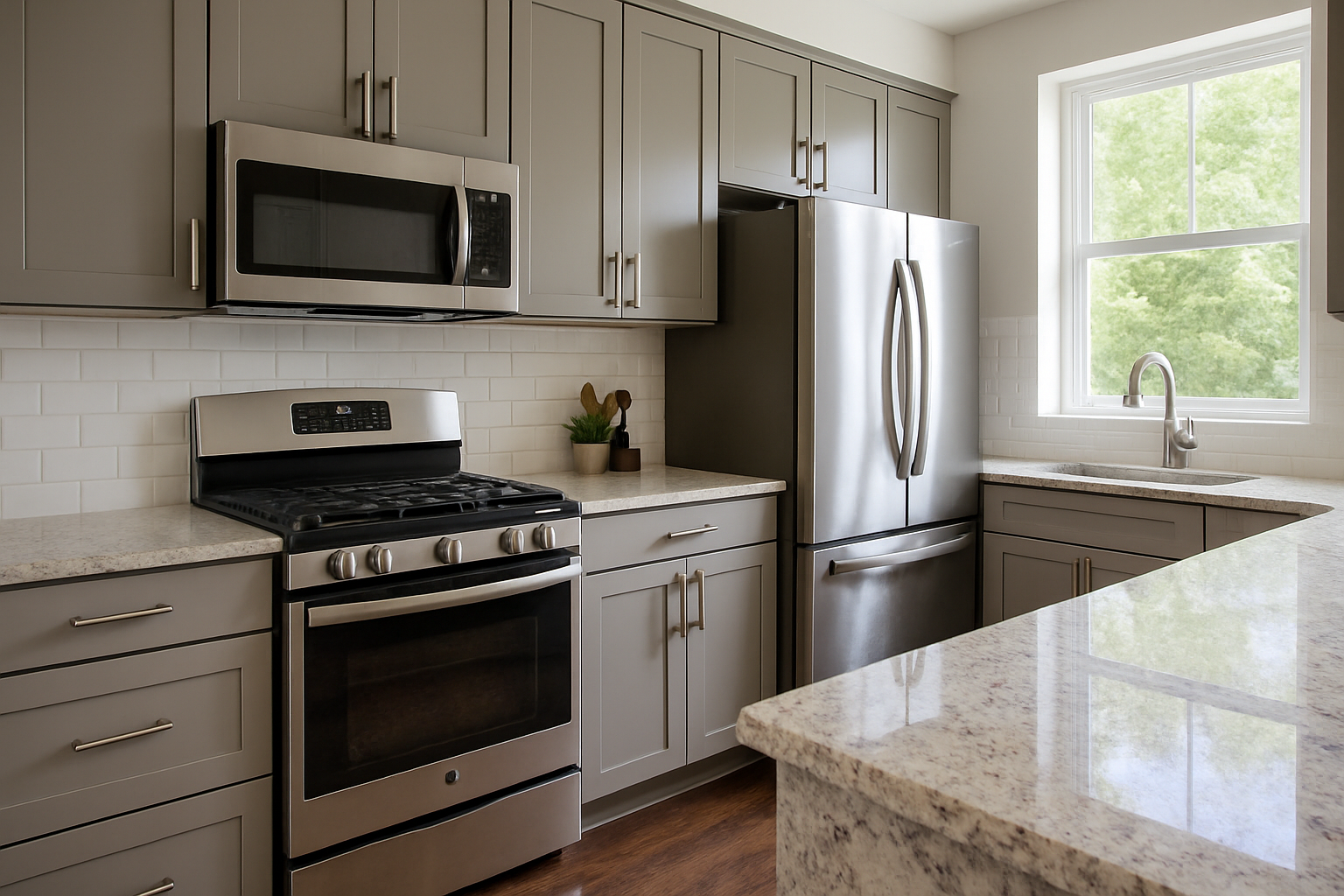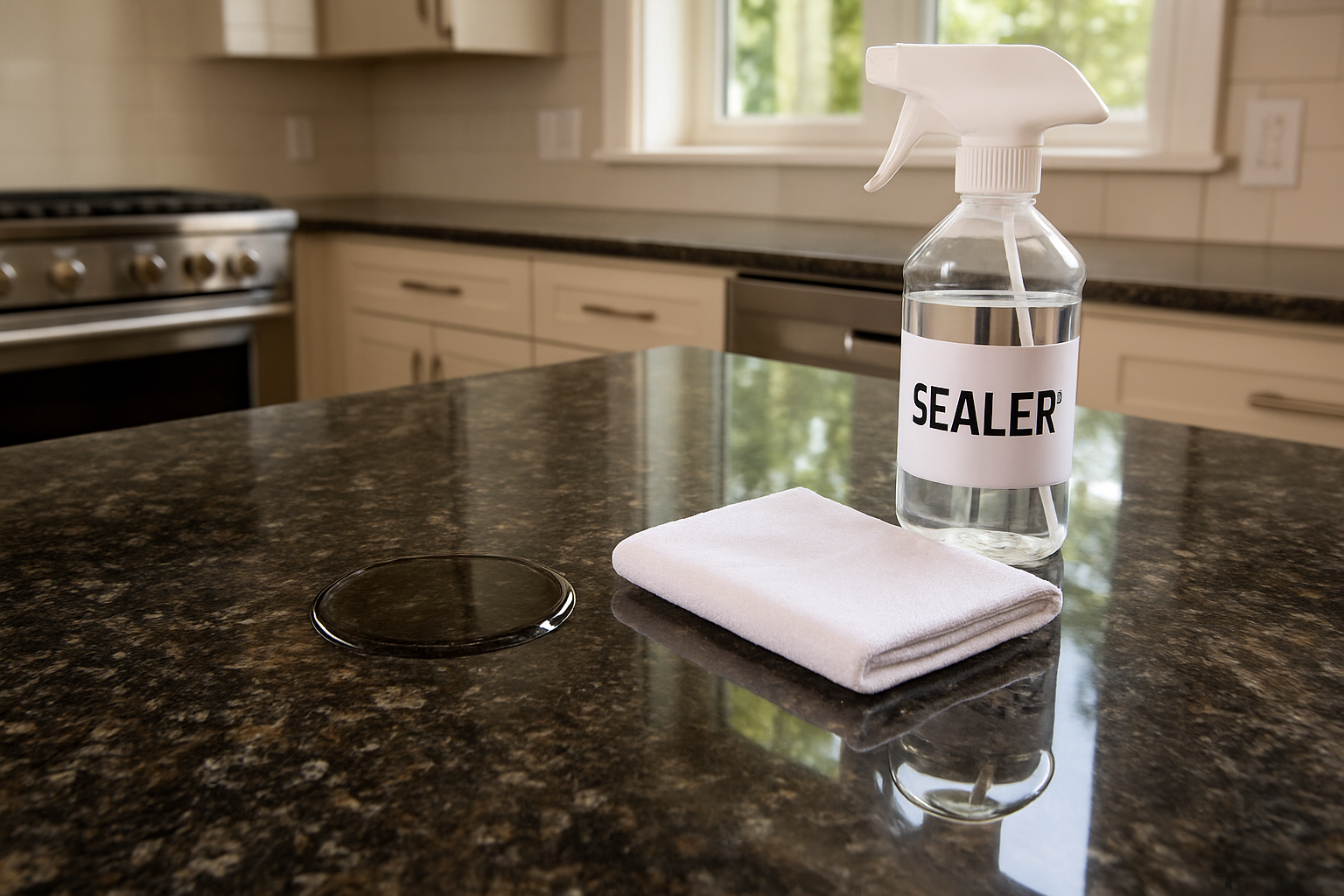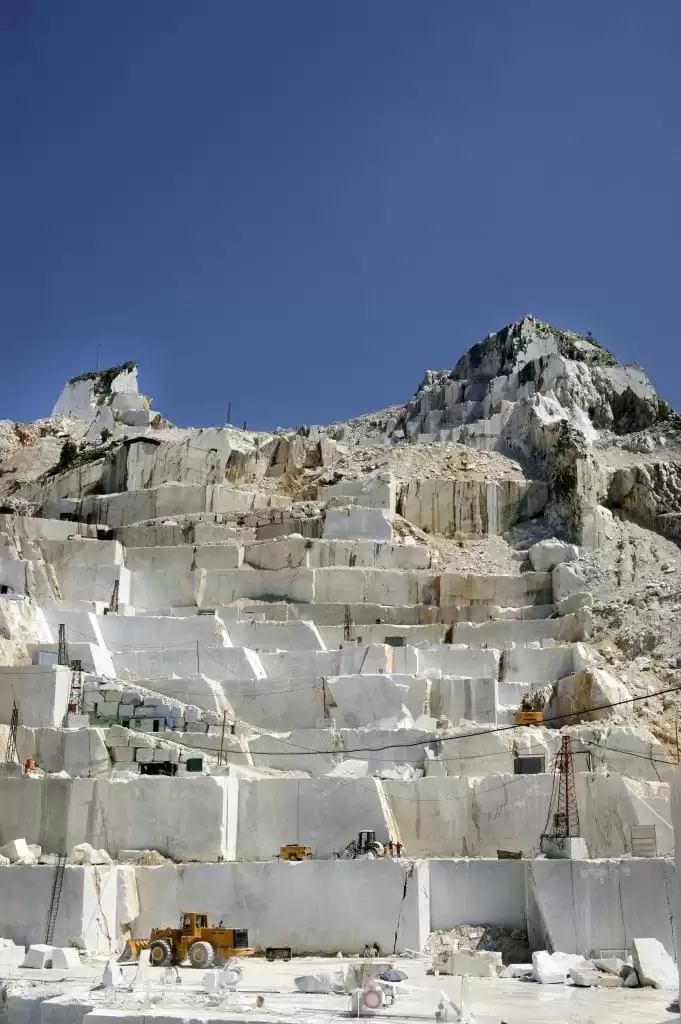How to Clean Granite Countertops: A Step-by-Step Guide

Last updated: December 2025
Learning how to clean granite countertops properly is essential for maintaining their beauty and durability. For daily cleaning, use warm water and mild dish soap with a soft cloth regularly. Avoid vinegar, bleach, or acidic substances as they'll remove the protective sealant over time.
Sealing frequency varies by granite type — test by dropping water on the surface. If it darkens, it needs sealing. For cloudy granite caused by residue buildup, use mineral spirits. If buildup is still stubborn, buff with dry fine steel wool using circular motions for a lustrous shine.
🪨 Understanding Granite Care: Since 1995 Fabricating and Installing in Greater Boston and Metro West
Most granite is the toughest and most durable stone surface you can install. According to the Natural Stone Institute, granite's durability makes it ideal for both residential and commercial applications. We've been using it in Greater Boston and Metro West Massachusetts since 1995. Most granite is exceptionally strong, but some exotic types can be more sensitive to certain cleaning products.
Some products can slowly damage your sealer with regular use. These include vinegar or citrus cleaners, bleach, ammonia-based products, glass cleaners like Windex, and all-purpose cleaners.
The granite will remain undamaged. However, using these chemicals often will wear away the protective coating. This will make your countertops more porous over time.
Occasional use is fine, but for daily cleaning, stick with simple soap and water. Many people reach for glass cleaners or vinegar out of habit, but these products can dull the finish over time with repeated use.
🧽 Daily Granite Cleaning
For daily cleaning, you need a few items. Gather warm water, dish detergent or mild soap, and a microfiber cloth or paper towel. A spray bottle is optional. You may also want a green or white scrub pad for tough spots.
Mix a few drops of dish soap in warm water in a spray bottle or bucket. Spray or apply the mixture, working with a soft cloth. For stubborn spots, use a green or white scrubby pad with the soapy water and a bit of elbow grease.
Wipe away all soap residue with clear water. Use a dry microfiber cloth to remove excess water right away. This helps prevent water spots.
Pro Tip: Clean spills immediately — wine, coffee, and cooking oil can stain if left sitting. Always make sure you leave no soap residue behind, as that causes cloudiness. After cleaning near the sink, wipe down the surrounding area to prevent water buildup.
🧹 Deep Cleaning Granite Countertops
You need to deep clean when you see buildup, grease spots, or dullness. This happens when your regular cleaning isn't enough.
Understanding how to clean granite countertops properly means not getting overwhelmed by complicated cleaning protocols you see online. Simply assess what you're looking at and address it accordingly. Every house is different — some cook constantly and need more frequent cleaning, others barely use their kitchen.
For problem spots, use more dish soap and a green scrubby pad for stubborn areas that need extra elbow grease. A baking soda paste works for stubbornly stuck-on dirt and debris — it's gentle yet effective for deep cleaning without scratching.
To disinfect, use a 50/50 isopropyl alcohol and water solution in a spray bottle. Do this after handling raw meat or when necessary. This is especially important around the sink and food prep areas. Isopropyl alcohol is one of the safest disinfectants for granite because it evaporates quickly and doesn't leave residue.
That's it. Clean what looks dirty regularly.
✨ How to Fix Cloudy Granite Countertops
Based on 30 years of fabrication experience
Why Granite Looks Cloudy
Residue buildup — soap, cleaning products, or sealer that didn't get wiped off properly causes most cloudiness. Most of the time, it's just surface buildup, not actual damage. Sometimes people accidentally use glass cleaners thinking they'll add shine, but this can actually contribute to cloudiness.
The Professional Fix
Expensive granite cleaners exist, but they're not absolutely necessary for this problem. Many people ask how to clean granite countertops when they look cloudy, and the answer is simpler than you think.
Start Simple:
1. Try Soap and Water First — Clean thoroughly with dish soap and warm water using a soft cloth. Wipe completely dry to remove excess water, then check if you see any cloudiness.
2. If it is still cloudy, use mineral spirits. Apply mineral spirits to a soft cloth. Wipe the cloudy areas to remove stubborn residue. Let dry completely.
3. If Still Visible — Dry Steel Wool — Use grade 00 steel wool when the surface is completely dry. Lightly buff cloudy spots in circular motions to restore the polish and shine.
4. Reseal if Needed — Apply granite sealer if you used mineral spirits and buff into the surface until dry.
Professional Note: Unless something actually penetrated the material, this method will handle virtually any cloudiness. In exceptionally rare cases with heavy commercial traffic, the surface can wear down and become dull. However, this is rare in a residential setting.
🏷️ Granite Types & Maintenance Requirements
Not all granite is created equal
Understanding Granite Origins
Many people think white granite countertops are more porous because they're thinking of marble, but that's not necessarily true. Granite porosity varies significantly by quarry and origin. Some materials are denser and have a quartz-like composition.
This makes them less absorbent. Other materials have a clay-like texture. They need more frequent sealing to protect the surface.
Honed materials are often more porous. The polished finish closes the pores more than the natural surface does.
Many slab manufacturers now use resins during fabrication to create a more uniform, glass-like finish and shiny appearance. This works like a super-sealer. Materials that usually need regular sealing often do not need it after resin treatment. You can tell if a slab has resin by looking at the edges for runoff marks.
Low Maintenance Varieties
Some granites require minimal upkeep and resist staining exceptionally well. Absolute Black is nearly indestructible, incredibly dense, and resists scratches.
Black Galaxy has minimal porosity and resists everything. Blue Pearl is dense with natural stain resistance, while Emerald Pearl has an exceptionally low absorption rate. Tan Brown is dense and needs minimal sealing.
American granites like Jet Mist and Virginia Mist (both blackish in color) are exceptionally durable and low maintenance. Dakota Mahogany, another American granite, offers excellent durability, and Barre Gray from Vermont is exceptionally dense.
Moderate Maintenance Varieties
Some popular granites need consistent but manageable care. Uba Tuba is beautiful but more porous than darker varieties. Santa Cecilia is common with moderate porosity, while New Venetian Gold requires consistent care. Brazilian granites like Typhoon Bordeaux, Crema Bordeaux, and Delicatus are popular choices, typically resin-enhanced during fabrication.
Higher Maintenance Varieties
Lighter granites generally require more attention. Kashmir White shows everything because of its light color. Ornamental White is extremely porous and stains easier. Giallo Ornamental needs frequent sealing, and Colonial White shows water marks quickly.
Testing Your Granite
Drop water on your countertops to determine sealing needs. If the water beads up, your granite is well sealed and needs no action. If it darkens quickly, you need to seal it soon. If it absorbs immediately, seal right away.
About Sealing
People make sealing sound complicated, but it's truly not a significant concern. A good water-based sealer like Bulletproof from StoneTech costs around $50 and is less smelly. Pour it on, spread it around, wait 5-10 minutes for it to soak in, and then wipe off the leftover residue on the surface. What soaked in clogs the pores — that's what actually does the job to protect your countertops.
🔧 Removing Stains from Granite Countertops
The Reality About Granite Stains
Most "stains" are actually just surface buildup that comes off with proper cleaning. True penetrating stains don't happen overnight — they take serious abuse. Even with porous materials, you'd need to leave something like red wine sitting for many hours or overnight to get a real stain.
The most common real stains appear around the stove in homes that cook frequently with oils and spices. The combination of heat, cooking oil, grease, and repeated spills without immediate cleanup can eventually penetrate granite. If something does absorb, use a hairdryer to dry the area right away, then apply sealer immediately. This method usually prevents any permanent staining.
Oil-Based Stains
For stains from cooking oil, butter, grease, or cosmetics, make a paste with baking soda and water. Mix until it is the consistency of toothpaste. Apply a thick layer over the stain and cover with plastic wrap, taping the edges.
Let sit overnight — as the baking soda paste dries, it pulls air in and automatically sucks anything out of the pores from inside out. Remove and wipe clean with dish soap and warm water.
Organic Stains
For coffee, wine, or fruit juice stains, mix baking soda with hydrogen peroxide to make a paste. Apply and cover the same way, leaving for several hours to sit and work.
Water Spots and Mineral Deposits
Water spots are usually just mineral deposits that buff away with a dry cloth. Hard water buildup often happens around sinks where water splashes a lot.
You can clean it with a baking soda paste. Gently scrub the paste on the affected area. Then, rinse it well with clear water.
Ink or Marker
Use acetone on a cotton ball, dabbing rather than rubbing to avoid scratches.
Professional Tip: Poultice powder is available at Home Depot or hardware stores. If the stain doesn't come out, it might be etching or damage needing professional restoration with specialized materials.
❓ Frequently Asked Questions About Granite Countertops
Can I use disinfectant on granite?
Yes, use 50/50 isopropyl alcohol and water in a spray bottle. Spray, let sit 3-5 minutes, then wipe with a soft cloth and dry. Avoid bleach-based disinfectants as they'll break down the sealer over time.
Why does my black granite show water spots and streaks?
Black granite shows everything — it's actually the most unforgiving color for water spots and fingerprints. Use minimal soap, rinse thoroughly with clear water, and always buff dry with a dry microfiber cloth. The spots are just mineral deposits from your water, not damage.
Can I put hot pots and pans directly on granite?
While granite handles heat extremely well, sudden temperature changes can cause thermal shock and cracking. More importantly, heat can temporarily open the pores, making it more vulnerable. Always use trivets to protect both the surface and the sealer.
How do I know if my granite is real?
Real granite feels cool when you touch it. It has unique natural patterns with small flaws and differences. No two slabs are the same. Fake granite feels warmer and has perfectly uniform, computer-generated patterns that repeat.
Should I choose granite or quartz?
Granite offers natural beauty, completely unique patterns, excellent heat resistance, but needs periodic sealing. Manufacturers create quartz for consistency, and it does not require sealing. However, it can burn from extreme heat and lacks natural character. Choose based on whether you want nature's uniqueness or engineered predictability.
Does this advice apply to other natural materials like marble?
Most natural stones — marble, quartzite, soapstone — share similar care principles. However, marble countertops are much more sensitive to acidic substances like vinegar, and each type has specific maintenance requirements.
Can I cut directly on granite?
Never cut directly on any natural surface. It dulls your knives and can damage the sealer, potentially causing scratches. Always use cutting boards to protect both your knives and your investment.
What's the best way to clean granite daily?
The best way is easy: use warm water with a few drops of mild dish soap. Wipe with a soft cloth. Rinse with clear water. Dry right away with a microfiber cloth to avoid water spots.
Are glass cleaners safe for granite?
While glass cleaners won't immediately damage granite, regular use can break down the protective sealer over time. It's best to avoid them and stick with pH-neutral cleaners or simply use mild dish soap and water.
Should I avoid vinegar on granite?
Yes. Vinegar is great for many cleaning tasks. However, it is acidic and can slowly break down granite sealer if used often. Occasional use won't cause immediate damage, but it shouldn't be your go-to cleaner for granite.
✅ Conclusion
Granite countertops are an excellent investment that can last a lifetime with proper care and maintenance. The key is knowing that granite is exceptionally durable. You don't need to treat it gently or worry too much about cleaning.
Most granite "problems" aren't significant problems at all. Cloudiness is usually just residue buildup. "Stains" are often surface issues that clean right off with dish soap and warm water. Water spots are just mineral deposits that wipe away with a dry cloth.
Learning to clean granite countertops well means knowing that granite can handle mistakes. It recovers from neglect better than other materials.
Clean surfaces that look dirty often. Use common sense when choosing cleaning products. Enjoy one of nature's most beautiful and strong surfaces.
Daily Maintenance Essentials: Clean every day with mild dish soap and warm water. Then, wipe with a dry microfiber cloth to remove extra water.
Avoid acidic substances and harsh chemicals. Use a spray bottle for easy application and work in circular motions for best results. Protect from hot pots with trivets, use cutting boards to prevent scratches, and test and maintain your sealer as needed.
👀 See For Yourself
The best way to choose granite is to see it in person. Visit our showroom to touch different materials, take samples home, and see how they look in your lighting. Every slab is unique, and photos don't capture the true depth and character of natural materials.
🏢 About Granite Guy Inc.
Based in Southborough, Massachusetts, fabricating and installing granite countertops since 1995 throughout Greater Boston, Metro West, and across Massachusetts. Visit our showroom to explore your options, or call 508-460-7900 for consultation and installation services.


